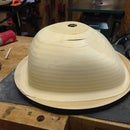Introduction: Urine Tanned Salmon Leather
Why urine?
Why not?
But seriously, if you're really curious about why we'd use our own urine to tan skin, skip to the last page and I'll tell you all about it.
Follow my set of instructions on how to prepare and tan salmon skin (or any other skin for that matter) to make leather.
Step 1: Assemble Your Kit
To tan a salmon skin, one must make a few preparations in advance. First I'll give you the list and then in the next steps I'll fill in the details about how to gather and prepare your key ingredients.
Salmon skins
1 to 2 gallons clean urine per skin
Equal parts water to urine
Dedicated soaking container with tight fitting lid
metal soup spoon
Latex gloves
Dish soap
Clean Plywood or pine 1x4 large enough to stretch skins
Staples, thumbtacks, or small nails
Step 2: First Prepare the Urine
We want only the best, cleanest urine for this project. Drink lots of water. Use a clean container. Make it fun- use a glass milk bottle or a wide mouth mason jar to collect your pee.
Now, I know most of you are making faces right now, but don't act new. How many of you have had to give a urine sample when at the doctor's? Well, go through the same steps you would if doing a urine sample and it will all come back to you.
Make sure to keep the container covered with a lid or a bit of plastic wrap, because you want to trap the ammonia in your solution and keep it from evaporating away.
Repeat this step until you have 1 to 2 gallons of urine for each salmon skin. If you're tanning a larger skin then be sure to have enough urine so the skin can float freely in your container. Later you'll mix this with equal parts water.
It may take a week or two for the ammonia in the urine to begin forming. Yes, it smells, but not as bad as a urinal or a public toilet smells. Your nose will tell you when the ammonia begins to form, but be careful not to sniff too closely, since ammonia gas can cause irritation of the nose and eyes.
The sources I used for my information had all sorts of interesting lore that went with traditional urine tanning of salmon skin. My favorite was a story about how only the urine of young girls was used. There may be something to all that, since there are different types of hormones and natural chemicals in our urine depending on our age, gender, and health. If you're the type to experiment, and something tells me those of you still reading just may be, it might be a good idea to sample different urines. Wild animals use urine to mark their territory and send messages to one another, and I can only guess that those odors are present to some extent in our urine as well.
For this I just used my own urine, since I had plenty of it.
Step 3: Prepare the Skins
Preparing the salmon skins is easy. The most important thing one must do with any skinning project is to prevent bad bacteria from colonizing the skin. Start with the freshest fish you can get- caught that day or the day before. This salmon was brought to us by Martin Reed from sustainable fish company i love blue sea, and was used in Maria Finn's Instructable called Breaking Down a Whole Salmon.
Cut the skin off as cleanly from the flesh as possible without cutting through it. Put it in a clean container and make sure not to contaminate it with offal or debris. We were rendering the whole fish for this project, so we just froze the skins immediately in freezer storage bags. Whatever you do, don't EVER salt the skins before freezing them, since it prevents them from freezing completely.*
Next, you take a metal soup spoon and use it to scrape the flesh from the skin. Remove all the fats, flesh, etc down to just the skin. Salmon skin is tough tough stuff, so don't be delicate here. Don't worry about the scales, since the urine will take care of those.
*If you're tanning another type of skin, say deer skin, then you'll probably be salting the skin as you remove it from the flesh. You can dry those skins in salt, or you can freeze them for later, but remember to rinse off all the salt before freezing or you could have problems later.
Step 4: Mix the Solution, Leave a Note
Mix equal parts urine to water into your water tight container*. You should have enough liquid to stir the skin and have it float freely. For this skin I used two gallons urine and two gallons water.
Make sure to leave a nice note so you don't surprise anyone if they come poking around your tanning solution. This solution in the tanning world is also called a pickle, FYI. You'll check the skin every day and give it a stir to keep bacteria from taking hold on any surfaces and get a nice, even finish.
*For this I used a short Rubbermaid roughneck tote, but the lid could be better. I normally use Rubbermaid Brute garbage cans and recommend those instead, but we had to keep this project inside so needed to save space and hide the bin under the utility sink. (Don't tell Facilities or Housecleaning- they'd be so grossed out).
Step 5: Pull Your Skin and Clean With Soap and Water
You'll check the skin every day and give it a stir. It should smell a little like fish, a little like hard boiled eggs, a little like ammonia. It shouldn't smell too awful, and if it stinks up the place for more than an hour or two when you open the lid, you need fresh solution because bacteria has set in. We use the same pickle for a second set of skins and had problems with bacteria, which tuned the skin pink in one place. Don't be lazy, change the urine as needed.
The skin will change from being really soft and gooey feeling in the pickle to more rubbery like a wet dish glove, with a squeeky feeling when you rub it between your gloved fingers. Feel is important, so get in there and touch it. You'll also start to see the scales flaking off, and that's a good sign you're getting close.
Depending on the temperature, your pickle will take anywhere from ten days to a month or more to cure the skin. Once it's finished curing, take it out and soap it up with dish soap several times. Lemon scented soap will help cut the scent, but keep in mind that you may develop a negative association with that brand or fragrance in the future. The skin will stink like old pee and dish soap when wet but as it dries that will go away. So will the funk in the room, I promise.
The soap will get rid of any remaining oils and salts in the skin and get it ready to dry.
Step 6: Dry Your Skin
Salmon skin is pretty stuff. The scales may or may not be still attached at this point. You want to lay your skin out in a cool, dry place out of direct sunlight and where no one will mess with it for a while. It will take a few days to dry. For this project we weren't interested in having the skin completely flat, and if you plan on breaking it for leather then there is no need to stretch it. Just lay it flat on a clean piece of scrap wood while it dries.
If you do want completely flat skin, then simply staple the very edges of the skin to the wood with close spacing and without stretching it too much, and as it dries it will shrink on its own.
Step 7: What to Do With Tanned Salmon Skin
Maria and I really loved the translucency of the salmon skin in its raw form, more as traditional parchment than worked leather. Dried flat like this, light passes through easily and the impression the scales left behind looks lovely. Maria worked with fellow artist Eric Foreman to develop lamps using the salmon to diffuse the light. Skin treated in this way can be rewetted and stretched over a form, and when it dries it will become tight like the skin of a drum.
If you are looking to use the salmon as leather for your project, you'll want to break it. Breaking leather is a process where you tear the fibers to make it soft and supple. Breaking is simple, but it takes a lot of muscle as you pull and stretch the dried skin over a hard edge until it becomes soft. Broken salmon leather will lose some of the evidence of the scales and be more like a rough suede. You may dye it, though I have not done so, and you'd dye it and then break it. Salmon leather has been used traditionally to make boots, gloves, and in other places where a tough leather is needed. Its very strong and durable.
Step 8: Why Urine?
Maria Finn lives for sustainable seafood and has written several books on her adventures on the ocean. We've been friends for a few years and are lucky to be part of the Artist in Residence program together at Autodesk's Pier 9 Workshop.
During salmon season this summer she went out and caught several big beautiful fish that she then used tip-to-tail for recipes she had developed while writing The Whole Fish. As part of her commitment to using all parts, she asked me to help her tan the skins to make salmon leather. I have some experience with using more natural methods and brain tanning for a series called Ghost Highway I showed at SOMarts in early 2014. After some consideration we decided to tan them in the traditional Inuit method using urine, since it's the easiest, least expensive, and is in keeping with her interest in tradition and sustainability.The Inuit people of the north were traditionally very resourceful and developed a method of tanning using a very sustainable and easily acquired tanning solution- their own urine.
Why urine? When our bodies and the bodies of all mammals break down amino acids as a part of normal metabolism, we produce ammonia. Ammonia is an amazing basic solvent that can break down fats and oils, clean surfaces and stop decay from forming. Since ammonia is toxic to us while in our bodies, our livers covert that ammonia into urea and salts, which we excrete in our urine. But that separation is only temporary, and when we contain that urine for any amount of time, the urea and salts bind back together to form ammonia again. Once you understand that the urine is a tanning chemical of mostly ammonia, it takes away the ick factor. Well, almost.
For more information about tanning in traditional methods, check out Lotta Rahme's book Leather: Preparation and Tanning by Traditional Methods.













